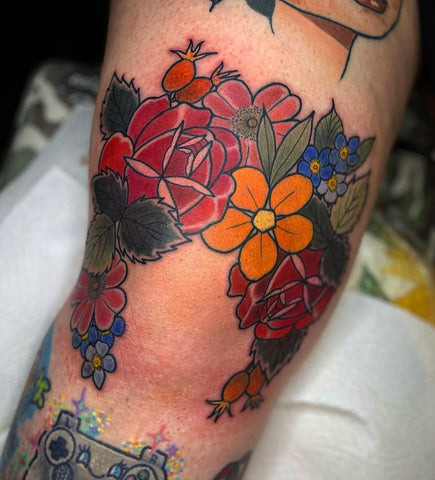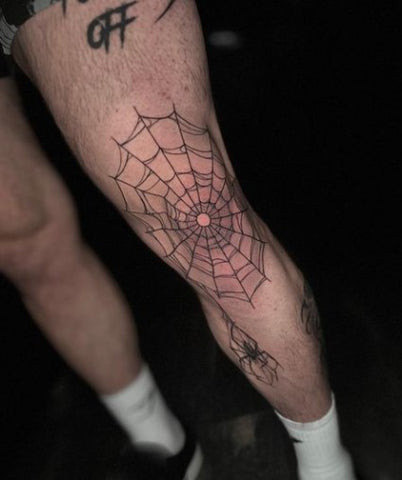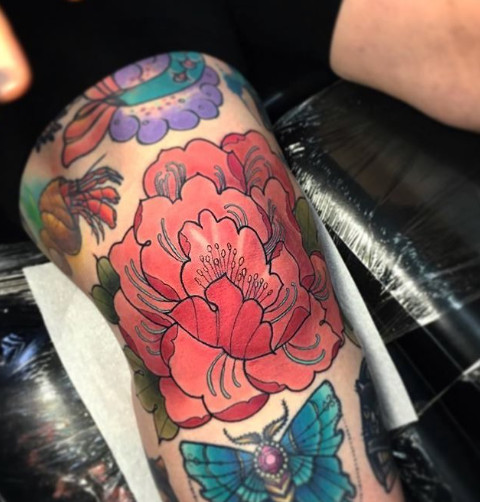How Bad Is A Knee Tattoo? Knee tattoos, a form of body art, certainly come with their own set of considerations, but with the right preparation and aftercare, you can get the stunning knee art you’re dreaming about. At tattooat.com, we’re dedicated to offering inspiration for your next piece of body art, expert advice, and the best artist connections. Keep reading to learn more about pain management tips, cost factors, and design inspiration to achieve the ultimate knee tattoo experience.
1. Do Knee Tattoos Hurt a Lot?
Yes, knee tattoos are generally considered to be among the more painful spots to get inked due to the proximity of bone and sensitive nerve endings. However, pain tolerance is subjective, and many find the discomfort manageable with proper preparation. According to tattoo artist Hanah Elizabeth (@hanahelizabethtattoo), knee tattoos can be “painfully uncomfortable to sit still for, but it wasn’t unbearable.” The overall consensus is that it’s a unique experience that varies from person to person.
1.1. Factors Influencing Pain Levels
Several factors can affect the pain experienced during a knee tattoo:
- Individual Pain Tolerance: Everyone experiences pain differently.
- Tattoo Placement: Areas directly over the kneecap tend to be more sensitive than those slightly above or below.
- Design Complexity: More intricate designs require longer sessions, potentially increasing discomfort.
- Artist Technique: An experienced artist can minimize pain through efficient and precise work.
- Mental Preparation: Knowing what to expect and mentally preparing for the session can significantly impact your perception of pain.
1.2. Comparing Knee Tattoo Pain to Other Areas
Compared to other common tattoo locations, knee tattoos are often ranked higher on the pain scale. Areas with more muscle and fat, such as the outer thigh or upper arm, tend to be less painful. However, areas with thin skin and close proximity to bone, like the ribs or feet, can be comparable in terms of discomfort. People with existing tattoos often compare knee pain to the elbow or shin, noting that the bony surface and nerve concentration contribute to the intensity.
1.3. Pain Management Strategies
Here are some strategies to help manage pain during a knee tattoo session:
- Choose an Experienced Artist: An artist with a steady hand and efficient technique can minimize trauma to the skin.
- Take Breaks: Don’t hesitate to ask for short breaks during the session to stretch, breathe, and mentally reset.
- Stay Hydrated and Well-Fed: Maintaining stable blood sugar levels can help your body cope with the stress of the tattoo process.
- Use Numbing Creams: Topical numbing creams can be applied before the session to reduce sensitivity.
- Distract Yourself: Listen to music, watch a movie, or chat with your artist to take your mind off the pain.
- Breathe Deeply: Focusing on slow, deep breaths can help calm your nervous system and reduce pain perception.
2. How Long Will My Knee Tattoo Take?
The duration of a knee tattoo depends on the intricacy, size, and color saturation of the design. Simpler blackwork tattoos generally take less time than complex, full-color pieces. As a general guideline, a small, simple design might take 2-3 hours, while a larger, more detailed tattoo could require 5-7 hours or more, potentially spread across multiple sessions.
2.1. Factors Affecting Tattoo Duration
- Design Complexity: Intricate patterns, fine lines, and detailed shading all require more time.
- Size of the Tattoo: Larger tattoos naturally take longer to complete.
- Color vs. Blackwork: Color tattoos typically require more time due to the need for multiple passes to achieve desired saturation.
- Artist’s Speed and Style: Some artists work faster than others, and different styles require varying levels of detail.
- Breaks and Adjustments: The need for breaks, stencil adjustments, and client comfort can also affect the overall duration.
2.2. Splitting Sessions for Large Tattoos
For larger, more complex knee tattoos, it’s common to split the work into multiple sessions. This allows for:
- Reduced Discomfort: Shorter sessions can help manage pain and fatigue.
- Better Healing: Allowing the skin to heal between sessions can improve ink retention and overall tattoo quality.
- Improved Focus: Both the artist and client can maintain better focus and concentration over shorter periods.
2.3. Examples of Tattoo Durations
Consider these real-world examples:
- A full-color pink peony knee tattoo by Hanah Elizabeth took approximately 4 hours with breaks.
- A peony knee tattoo by Toby Gawler required 5-6 hours over two sessions.
These examples highlight how design complexity and color saturation can influence the duration of a knee tattoo.
3. How Much Does a Knee Tattoo Cost?
The cost of a knee tattoo varies significantly based on factors such as the artist’s hourly rate, the size and complexity of the design, and the location of the studio. Generally, you can expect to pay anywhere from $150 to $1000 or more for a knee tattoo. Many artists charge by the hour, with rates ranging from $100 to $250 per hour.
3.1. Cost Factors
- Artist’s Hourly Rate: Experienced and in-demand artists typically charge higher hourly rates.
- Design Size and Complexity: Larger, more detailed designs require more time and therefore cost more.
- Color vs. Blackwork: Color tattoos usually cost more due to the added time and materials.
- Studio Location: Studios in major cities or high-end areas often have higher prices.
- Custom vs. Flash Design: Custom designs, which are created specifically for you, tend to be more expensive than choosing a pre-drawn “flash” design.
3.2. Pricing Models
- Hourly Rate: Many artists charge an hourly rate, which is multiplied by the estimated time to complete the tattoo.
- Per Piece: Some artists, especially for smaller or simpler designs, may offer a fixed price per piece.
- Minimum Charge: Most studios have a minimum charge to cover setup and material costs, even for very small tattoos.
3.3. Budgeting Tips
- Consult with Multiple Artists: Get quotes from several artists to compare prices and styles.
- Be Realistic: Understand that quality tattoos require time and skill, so don’t automatically go for the cheapest option.
- Factor in Aftercare: Budget for aftercare products like specialized lotions and cleansers.
- Consider Payment Plans: Some studios offer payment plans or financing options for larger tattoos.
4. How Do I Prepare for a Knee Tattoo?
Proper preparation is crucial for a successful knee tattoo experience. This includes both physical and mental preparation to ensure your skin is ready, you can manage the pain, and the healing process goes smoothly.
4.1. Pre-Tattoo Skincare
- Exfoliate: Gently exfoliate the knee area a few days before your appointment to remove dry, dead skin cells. Stories & Ink exfoliating body wash is a great choice for getting your skin ready to be tattooed. It can also be used on healed tattoos to help them stay bright.
- Moisturize: Keep the skin well-hydrated by applying a fragrance-free moisturizer daily leading up to your appointment.
- Avoid Sunburn: Protect your knee from sun exposure, as sunburned skin is not suitable for tattooing.
- Shave: If necessary, shave the area the day before your appointment.
4.2. What to Wear
- Comfortable Clothing: Wear loose-fitting clothing that allows easy access to your knee.
- Dark Colors: Choose dark colors to minimize the visibility of any ink stains.
- Consider the Placement: If the tattoo extends above or below the knee, adjust your clothing accordingly.
4.3. Day-Of Preparations
- Eat a Good Meal: Have a substantial meal before your appointment to maintain stable blood sugar levels.
- Stay Hydrated: Drink plenty of water to keep your skin hydrated and improve your body’s ability to cope with the tattooing process.
- Avoid Alcohol and Blood Thinners: Refrain from consuming alcohol or taking blood-thinning medications, as they can increase bleeding during the procedure.
- Bring Entertainment: Bring a book, music, or other forms of entertainment to help distract yourself during the session.
- Communicate with Your Artist: Discuss any concerns or questions you have with your artist before the tattooing begins.
5. How Should I Choose My Knee Tattoo Placement?
Knee tattoos offer several placement options, each with its own aesthetic and considerations. Common placements include:
5.1. Kneecap Tattoo
A kneecap tattoo covers the kneecap directly. These tattoos are often standalone designs in a traditional style, such as a peony, bear head, rose, mandala, or sacred heart.
 Knee cap tattoo by Hanah Elizabeth
Knee cap tattoo by Hanah Elizabeth
5.2. Above Knee Tattoo
An above knee tattoo sits just above the kneecap, almost on the lower thigh. This spot is ideal for floral frames around the knee, butterflies, cut-out mandalas, or barbed wire. Some people opt for a two-word phrase across both legs.
 Above the knee tattoo by Hanah Elizabeth
Above the knee tattoo by Hanah Elizabeth
5.3. Under Knee Tattoo
An under knee tattoo frames the kneecap from underneath, also known as an upper shin tattoo. Suitable designs include horseshoes, chunky charm bracelets, flowers, floral bands, moths, and bats.
5.4. Incorporating Knee Tattoos into Larger Designs
The knees can be integrated into a larger leg sleeve or treated as individual pieces. Consult your tattoo artist to determine the best approach for your desired design.
6. How Do I Heal a Knee Tattoo Properly?
Knee tattoos can be challenging to heal due to the skin’s constant movement and stretching. Proper aftercare is essential to prevent infection, minimize scarring, and ensure the tattoo heals properly. According to tattooist Hanah, “it’s tender and super swollen for a few days after so, if you can, take a few days off and rest as that will definitely help.”
6.1. Initial Aftercare (Days 1-3)
- Keep it Clean: Gently wash the tattoo with mild, fragrance-free soap and warm water 2-3 times a day.
- Pat Dry: Pat the area dry with a clean paper towel, avoiding rubbing.
- Apply Aftercare Ointment: Apply a thin layer of aftercare ointment, such as Aquaphor or specialized tattoo balm, to keep the skin moisturized.
- Cover the Tattoo: Keep the tattoo covered with a sterile bandage or breathable tattoo film for the first 24-48 hours, or as directed by your artist.
6.2. Ongoing Aftercare (Weeks 1-4)
- Moisturize Regularly: Continue to apply a fragrance-free moisturizer several times a day to prevent the skin from drying out. Stories & Ink Daily Moisturiser is packed with fade fighting ingredients to keep tattoos looking their best.
- Avoid Soaking: Refrain from soaking the tattoo in baths, pools, or hot tubs. Showers are fine, but keep them brief.
- Protect from Sun: Keep the tattoo protected from direct sunlight, as UV rays can cause fading and damage.
- Don’t Pick or Scratch: Avoid picking at scabs or scratching the tattoo, as this can lead to infection and scarring.
- Wear Loose Clothing: Wear loose-fitting clothing to minimize friction and irritation.
- Stay Hydrated: Drink plenty of water to keep your skin hydrated from the inside out.
6.3. Special Considerations for Knee Tattoos
- Elevate Your Leg: Elevating your leg can help reduce swelling and promote healing.
- Limit Movement: Avoid excessive bending or kneeling, as this can irritate the tattoo.
- Listen to Your Artist: Follow the specific aftercare instructions provided by your tattoo artist.
6.4. Addressing Potential Problems
- Infection: If you notice signs of infection, such as redness, swelling, pus, or fever, seek medical attention immediately.
- Allergic Reaction: If you experience itching, rash, or hives, you may be having an allergic reaction to the ink or aftercare product. Consult your doctor or tattoo artist.
- Excessive Scarring: If you’re prone to keloid scarring, discuss this with your artist beforehand, as knee tattoos may be more susceptible to scarring due to the skin’s movement.
7. Do Knee Tattoos Fade Quickly?
While all tattoos fade over time due to sun exposure and natural skin cell turnover, knee tattoos are not necessarily more prone to fading than tattoos in other locations. With proper aftercare and sun protection, you can help keep your knee tattoo looking vibrant for years to come. According to Hanah, “everyone’s skin heals differently but, as long as you’re keeping your skin moisturised, there’s no reason why they should fade faster than others.”
7.1. Factors Affecting Tattoo Fading
- Sun Exposure: UV rays are the primary cause of tattoo fading.
- Skin Hydration: Dry skin can cause the tattoo to look dull and faded.
- Ink Quality: High-quality inks tend to hold their color better over time.
- Tattoo Placement: Areas that experience a lot of friction or movement may fade more quickly.
- Individual Skin Type: Some skin types retain ink better than others.
7.2. Tips to Prevent Fading
- Sunscreen: Apply a high-SPF sunscreen to your tattoo whenever it’s exposed to the sun.
- Moisturize Regularly: Keep your skin well-hydrated by applying a fragrance-free moisturizer daily.
- Avoid Harsh Chemicals: Avoid using harsh soaps, exfoliants, or chemicals on your tattoo.
- Healthy Lifestyle: A healthy diet and lifestyle can contribute to overall skin health and ink retention.
8. Can I Get a Knee Tattoo After Surgery?
Yes, you can get a tattoo after knee surgery, but it’s crucial to wait until the area is fully healed. Tattooing over scars can be a great way to boost self-esteem and reclaim your body image.
8.1. Timing Considerations
- Consult Your Surgeon: Ask your surgeon how long you should wait before getting a tattoo over the surgical area.
- Full Healing: Ensure that your knee and any scars are completely healed before considering a tattoo. This may take several months or even a year.
- Scar Tissue: Be aware that tattooing over scar tissue can be more challenging, as the skin may be thicker and less elastic.
8.2. Choosing an Artist
- Specialized Artist: Find a tattoo artist who specializes in tattooing over scars. These artists have experience working with different skin textures and can help you choose a design that will work well with the scar tissue.
- Open Communication: Discuss your surgical history and concerns with your artist to ensure they understand the unique challenges of tattooing over scars.
8.3. Design Considerations
- Camouflage or Enhancement: Decide whether you want to camouflage the scar or incorporate it into the tattoo design.
- Avoid Irritation: Choose a design that won’t cause excessive irritation or friction to the scar tissue.
- Placement: Consider the placement of the tattoo to minimize any discomfort or restrictions in movement.
9. Top 5 Knee Tattoo Ideas
Need some inspiration for your knee tattoo? Here are five popular ideas:
9.1. Knee Mandala Tattoo
Mandala tattoos are ornamental and look great on their own or as part of a sleeve.
9.2. Knee Spider Web Tattoo
Classic cobweb tattoos look amazing anywhere, from the top of the ears to the knees.
 Knee tattoo by Tom Stals
Knee tattoo by Tom Stals
9.3. Floral Knee Tattoos
Flowers always make great tattoos. Peonies are a popular choice for knee tattoos.
 Rosie's pink peony knee tattoo by Hanah Elizabeth
Rosie's pink peony knee tattoo by Hanah Elizabeth
9.4. Industrial Knee Tattoos
Chain locked fence tattoos have gained popularity in the tattoo world.
9.5. The Bee’s Knees
Bee tattoos placed under the knees are a fun and punny option.
10. Frequently Asked Questions About Knee Tattoos
Here are some frequently asked questions about knee tattoos:
10.1. Are knee tattoos more prone to infection?
No, knee tattoos are not inherently more prone to infection than tattoos in other locations. However, due to the knee’s constant movement, proper aftercare is essential to prevent infection.
10.2. Can I exercise after getting a knee tattoo?
It’s best to avoid strenuous exercise that puts stress on the knee joint for at least a week after getting a knee tattoo. Light activities like walking are generally fine, but listen to your body and avoid anything that causes pain or irritation.
10.3. How can I find a reputable tattoo artist for my knee tattoo?
Research local tattoo studios and artists online, read reviews, and check out their portfolios. Look for an artist with experience in the style you want and a reputation for cleanliness and professionalism.
10.4. What should I do if my knee tattoo is swelling?
Some swelling is normal after getting a knee tattoo. Elevate your leg, apply a cold compress, and take over-the-counter anti-inflammatory medication if needed. If the swelling is excessive or accompanied by other symptoms, consult a doctor.
10.5. Can I use numbing cream before getting a knee tattoo?
Yes, topical numbing creams can be used before getting a knee tattoo to reduce pain. Talk to your artist about which numbing creams are safe and effective.
10.6. How often should I moisturize my knee tattoo?
Moisturize your knee tattoo several times a day, especially during the healing process. This will help keep the skin hydrated, prevent scabbing, and promote healing.
10.7. What kind of clothing should I wear to my knee tattoo appointment?
Wear loose-fitting clothing that won’t rub against your new tattoo. Shorts or loose pants are ideal.
10.8. Can I still kneel after getting a knee tattoo?
Avoid kneeling directly on your new tattoo until it’s fully healed. This can cause irritation and disrupt the healing process.
10.9. How long does it take for a knee tattoo to fully heal?
A knee tattoo typically takes 2-4 weeks to fully heal, but this can vary depending on individual factors and aftercare practices.
10.10. Is it okay to wrap my knee tattoo at night?
Wrapping your knee tattoo at night can help protect it from friction and contamination. Use a breathable bandage or tattoo film, and make sure to change it regularly.
Ready to explore the world of knee tattoos? Visit tattooat.com today for inspiration, artist connections, and expert advice. Discover unique designs, find talented artists in your area, and learn everything you need to know about the tattoo process. Let tattooat.com be your guide to achieving the perfect knee tattoo experience! Address: 1825 SW Broadway, Portland, OR 97201, United States. Phone: +1 (503) 725-3000.